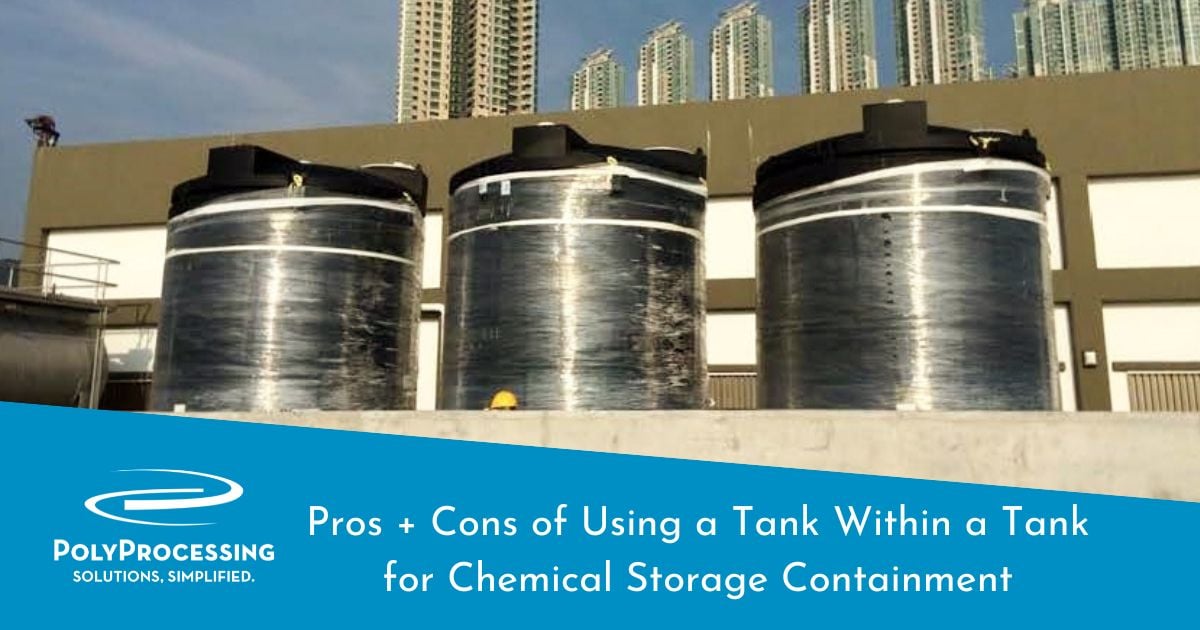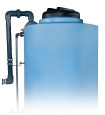Pros + Cons of Using a Tank Within a Tank for Chemical Storage Containment
Secondary containment systems — a.k.a a tank within a tank — are recommended safeguards that can prevent costly damage to equipment and risk to employees in the event of a leak or failure of the primary storage vessel.
There are several secondary containment options with varying costs available to tank owners. Let’s compare a traditional permanent concrete structure to a sophisticated, integrated double-wall tank containment system. The cost analysis may surprise you.

Concrete Containment Structures: The Traditional Method
Traditionally, chemical containment systems are composed of large, concrete basins that surround a primary storage tank. While this solution adds a layer of protection, it also adds costs, square footage, and high-maintenance complications. If a spill occurs in a concrete secondary containment, the spilled chemical is usually unrecoverable because of contamination. You’ll need to clean out the containment area, replace the lost product, and possibly recoat the concrete basin.
The Cost of Concrete Containment
Unfortunately there are several costs that are specifically involved with concrete containment structures. First, the cost of the concrete itself has to be accounted for. Building vertical walls of concrete is expensive, especially when it is reinforced with rebar.
Second, consider the cost of coating the concrete with an anti-corrosive material that will protect its integrity in the event of a spill. There’s also the ongoing maintenance of the concrete itself.
If a chemical spill does happen, the chemicals that spill must be disposed of, since they will be contaminated by the dirt and debris that has built up in the containment area. Also, you will need to clean out the containment structure and then re-coat the concrete with the protective substance before you can use the tank again, since this coating normally only protects the concrete from spills one time.
An Integrated Secondary Containment Alternative
The SAFE-Tank is a double wall plastic storage tank that provides a “tank-within-a-tank” to safely store chemicals. The system prevents damage and injury from chemical exposure without the need for an additional containment unit.
Double wall tanks offer superior protection against hazardous chemical spills for personnel and the environment. The SAFE-Tank provides a minimum of 110% secondary containment by enclosing the primary storage tank within a properly designed outer tank. Any chemical leak in the inner tank is fully contained in the outer shell.
The inner tank dome overlaps the outer tank sidewall to help prevent rainwater, debris, and other contaminants from entering the containment area. You can continue to use the chemical until the primary tank is drained and an inspection is performed to find the source of a possible leak.
Because of the double wall configuration, the SAFE-Tank requires a specialized fitting to ensure that your chemical doesn’t leak when it’s discharged. A unique bellows transition fitting enables the liquid to discharge at the bottom of the tank while maintaining the integrity of the containment. With the bellows transition fitting, safe chemical discharge from the primary tank occurs, allowing for tank expansion and contraction.
WATCH THE VIDEO BELOW TO SEE HOW THE SAFE-TANK® SYSTEM WORKS.
Advantages of the SAFE-Tank
The SAFE-Tank system offers safe storage of a wide variety of chemicals without the expense of needing to construct permanent containment, such as a concrete basin or vessel. This gives you cost effective flexibility for changing industrial applications. As chemical storage configurations may change to meet dynamic needs, you can move chemical storage without incurring the expense of additional containment structures.
SAFE-Tanks also provide the following advantages for your business:
- 110% secondary containment. The double wall chemical storage tank system uses equalization to provide a minimum of 110% of the working volume of the primary tank.
- Liquid equalizes in the unlikely event of a leak. This allows you to continue using the chemical within the primary tank until the tank system can be emptied, inspected and repaired in the unlikely event of a leak.
- Durable polyethylene. The outer tank is constructed with the same high-density crosslinked polyethylene (XLPE) as the inner storage tank. XLPE is specifically engineered to accommodate the demands of hazardous material.
- Lower costs and maintenance. The self-contained double wall that a SAFE-Tank offers is much less expensive upfront and easier to maintain than a concrete basin. It can eliminate the expensive costs of concrete and its ongoing maintenance.
- Ideal for sulfuric acid and other harmful chemicals. The double wall storage tank eliminates potential exposure and dangerous chemical reactions, such as sulfuric acid to water.
- Excellent for outside storage. The secondary containment vessel is sealed from the elements, so that no debris or rainwater can contaminate the chemical being stored. Many customers have a back-up SAFE-Tank they can fill when they need more chemical throughput or if there are supply chain issues.
- Ideal for sulfuric acid and other harmful chemicals. The double wall storage tank eliminates potential exposure to dangerous chemicals, and reactions to water.
- Bottom discharge. A bellows transition fitting enables discharge from the bottom of the tank, while maintaining the integrity of the containment. The bellows transition fitting permits safe chemical discharge from the primary tank. It also allows the tank to expand and contract due to filling, emptying, and temperature variation.
The SAFE-Tank is designed with wall thicknesses equal to or greater than that required by ASTM D-1998 standards.
SAFE-Tank Accessories
Poly Processing’s double wall tanks can be customized by adding accessories to fit your specific needs. Some of our most popular double wall tank accessories include:
- Bellows Transition Fitting
- Seismic Restraint Systems
- Wind Restraint Systems
- Ultrasonic level Indicator
- Leak Detection Systems
- Heat Maintenance Systems
- Ladders
- Overflow Assembly
The Smart Chemical Storage Solution
Safe chemical storage is smart chemical storage. The costs associated with damage from a chemical leak or spill are serious for any business. In addition, it is expensive to take a tank offline and interrupt operations for repair. The SAFE-Tank system eliminates these costs, maintenance and safety concerns while reducing the footprint to the area of a standard upright storage tank.
Discover more benefits of a SAFE-Tank, download our guide today.
- July 17, 2023
- Topics: Value Added, FAQs
About Poly Processing
Posts By Topic
Tech Talk Podcast Episodes
Subscribe By Email
Recent Posts
- Installation Tips for Chemical Storage Tanks: Site Preparation and Offloading
- Understanding pH and Chemical Concentration When Choosing a Chemical Tank
- Maximizing Fill Efficiency: Selecting the Optimal Fill Line System
- Chemical Storage Tanks: A Quick Guide for End Users
- Popular Customization Options for Chemical Storage Tanks
Tank Configurator

Find the recommended tank and system components for your chemical storage challenge.
Configure a Tank Package




